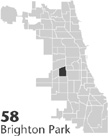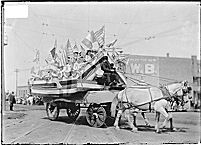| Entries |
| B |
|
Brighton Park
|
 Community Area 58, 6 miles SW of the Loop. Brighton Park takes its name from the Brighton livestock market in England and is bounded roughly by the Stevenson
Expressway
and 48th, Western, and Kimball Streets. Construction of the
Illinois & Michigan Canal
and Archer Avenue drew early settlers. Henry Seymour subdivided land north of Pershing Road in 1835. By 1851, there was a small settlement named Brighton Park near the Blue Island Avenue Plank Road (now Western Avenue). In 1855 Mayor Long John Wentworth opened the Brighton Race Track.
Community Area 58, 6 miles SW of the Loop. Brighton Park takes its name from the Brighton livestock market in England and is bounded roughly by the Stevenson
Expressway
and 48th, Western, and Kimball Streets. Construction of the
Illinois & Michigan Canal
and Archer Avenue drew early settlers. Henry Seymour subdivided land north of Pershing Road in 1835. By 1851, there was a small settlement named Brighton Park near the Blue Island Avenue Plank Road (now Western Avenue). In 1855 Mayor Long John Wentworth opened the Brighton Race Track.

|
The Chicago & Alton Railroad established a roundhouse in the community, and industrial employment attracted German and Irish workers. In 1887 the Santa Fe Railroad moved in, building its Corwith Yards, then the busiest in the nation.
In 1889 Brighton Park was annexed to the city of Chicago as part of Lake Township. By the 1880s and 1890s infrastructure and transportation improvements drew even more diverse populations. French and Eastern European Jews settled in the community, followed by Poles, Lithuanians, and Italians.
Much of the ethnic character of the community was carried by the churches. The first churches in the community were Protestant, serving the Yankees who owned and managed the early firms. The Brighton Park Baptist Church dates from 1848, and the McKinley Park Methodist Church first met in 1872. In 1878 Irish Roman Catholics established St. Agnes Church. By 1892 French Catholics had established St. Jean Baptiste church at 33rd and Wood Streets. Later, Italians, Poles, and Lithuanians found jobs and homes in Brighton Park. They developed their own churches, including Five Holy Martyrs in 1908 (Polish); Immaculate Conception in 1914 (Lithuanian); St. Pancratius in 1924 (Polish); and St. John's Polish National Parish, also in 1924.
Industrial parks such as the Central Manufacturing District opened in 1905, and the Kenwood Manufacturing District opened on the southern border around 1915. The Crane Manufacturing Company opened a plant in 1915, providing more jobs. By 1930, Brighton Park reached residential maturity, peaking at 46,552 people, 37 percent of Polish descent. Deindustrialization, exemplified by the closing of Crane's in 1977, weakened the area's economy, and population declined by one-third between 1930 and 1980.
Although the community remains largely residential, there is a growing commercial section. The community maintains monuments to European connections, including the Balzekas Museum of Lithuanian Culture and the Polish Highlander Alliance. By 2000 the population had grown to 44,912, 69 percent of Mexican origin.
| Brighton Park (CA 58) | |||||
| Year |
Total
(and by category) |
Foreign Born | Native with foreign parentage | Males per 100 females | |
| 1930 | 46,552 | 30.3% | 51.4% | 108 | |
| 46,065 | White (99.0%) | ||||
| 41 | Negro (0.1%) | ||||
| 446 | Other (1.0%) | ||||
| 1960 | 38,019 | 20.4% | 33.7% | 99 | |
| 37,948 | White (99.8%) | ||||
| 36 | Negro (0.1%) | ||||
| 35 | Other races (0.1%) | ||||
| 1990 | 32,207 | 29.3% | — | 95 | |
| 23,861 | White (74.1%) | ||||
| 19 | Black (0.1%) | ||||
| 60 | American Indian (0.2%) | ||||
| 698 | Asian/Pacific Islander (2.2%) | ||||
| 7,569 | Other race (23.5%) | ||||
| 12,044 | Hispanic Origin* (37.4%) | ||||
| 2000 | 44,912 | 46.3% | — | 106 | |
| 22,861 | White alone (50.9%) | ||||
| 330 | Black or African American alone (0.7%) | ||||
| 415 | American Indian and Alaska Native alone (0.9%) | ||||
| 1,326 | Asian alone (3.0%) | ||||
| 29 | Native Hawaiian and Other Pacific Islander alone (0.1%) | ||||
| 18,054 | Some other race alone (40.2%) | ||||
| 1,897 | Two or more races (4.2%) | ||||
| 34,409 | Hispanic or Latino* (76.6%) | ||||
The Encyclopedia of Chicago © 2004 The Newberry Library. All Rights Reserved. Portions are copyrighted by other institutions and individuals. Additional information on copyright and permissions.